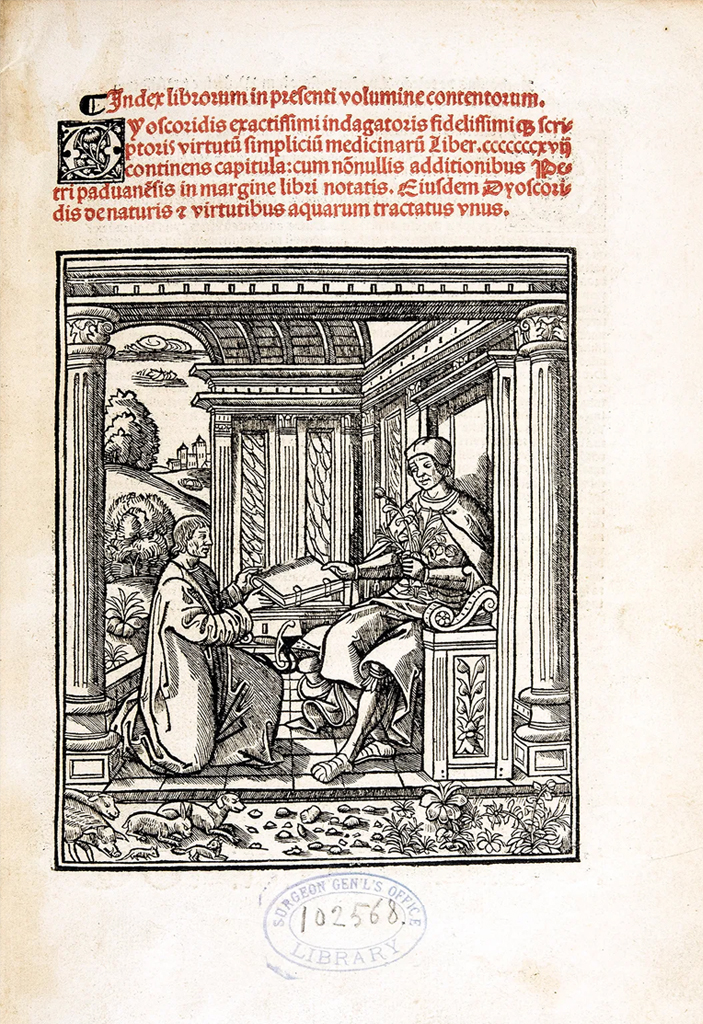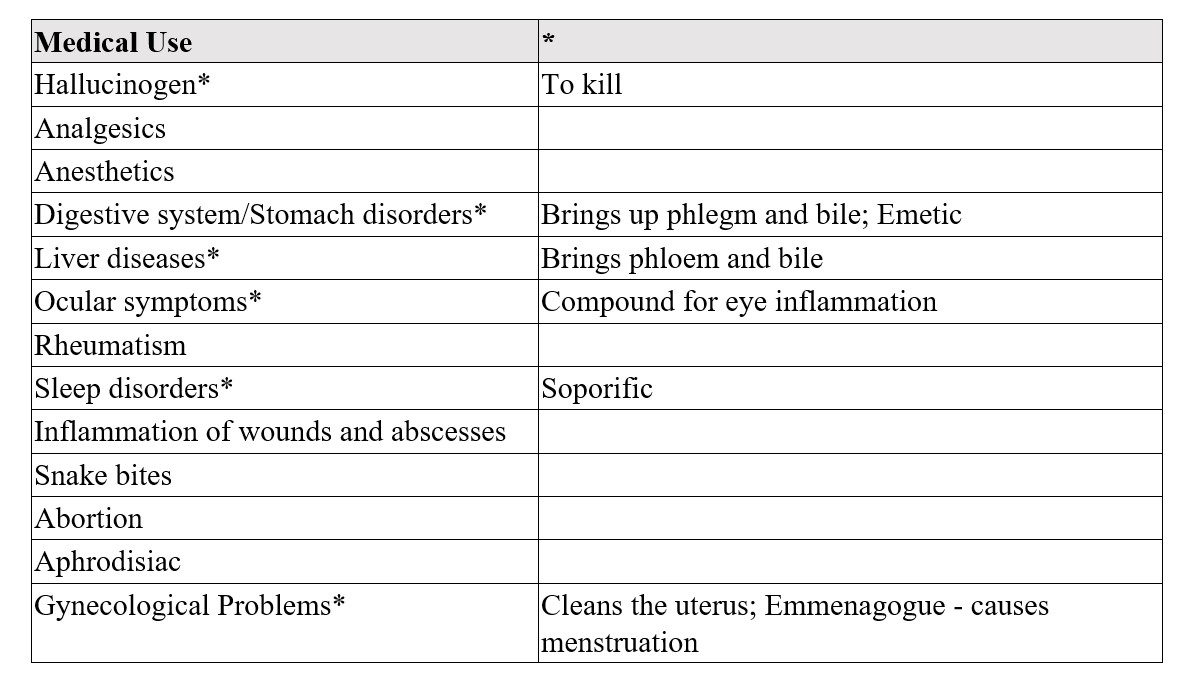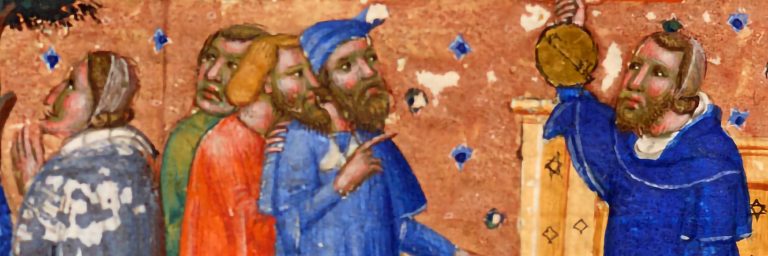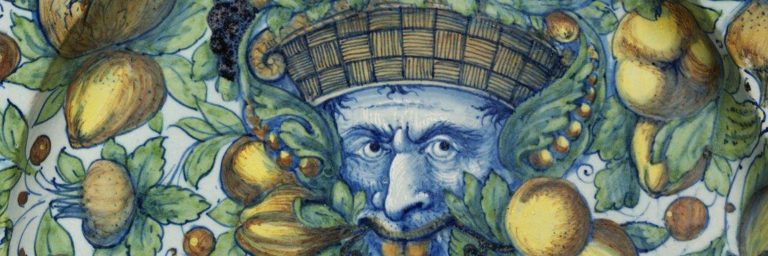Dioscorides and the Madrake

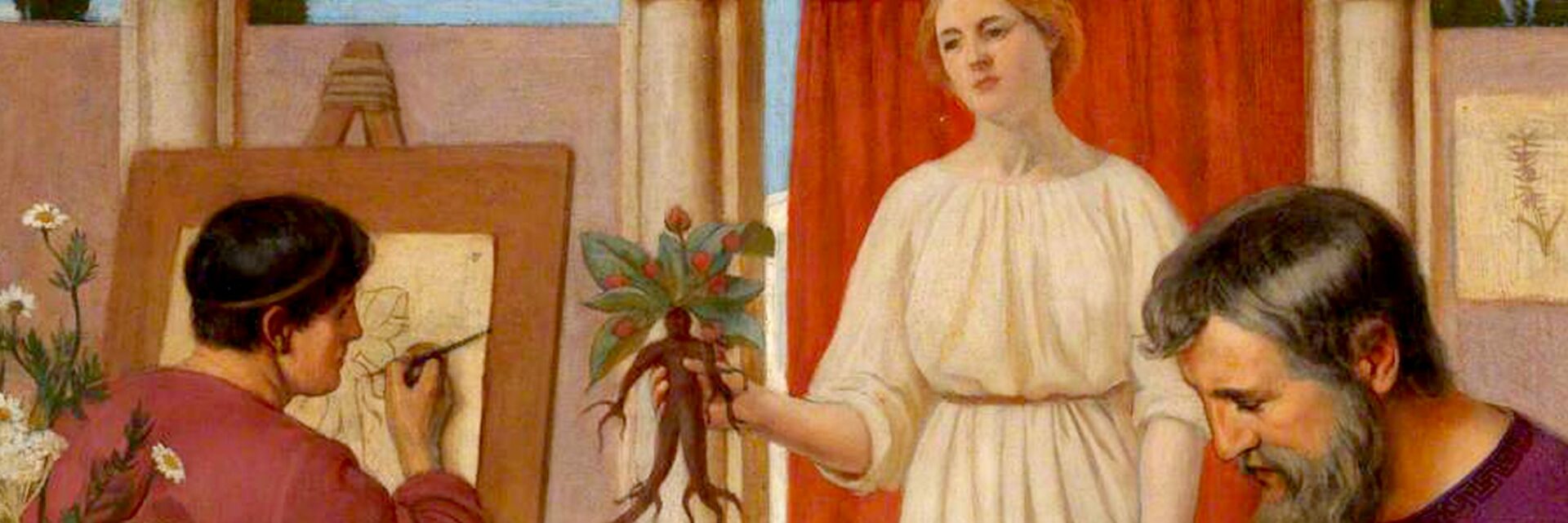
FORMA FLUENS
Histories of the Microcosm
Dioscorides and the Mandrake
Changing Historical Conceptions
and Medical Uses
Maria Débora Pereira
University of Lisbona
Comèl Grant

Dioscorides’ De materia medica was the main historical source of information on the medicines used by the Greeks, Romans and other cultures of antiquity, making it one of the most enduring books in all of natural history and pharmacology. Unlike the works of many classical authors, Dioscorides’ work was not “rediscovered” in the Renaissance, it simply never went out of circulation. De materia medica (composed at around 77 AD, Fig. 1) consisted of five books and was dedicated to Laecanius Arius, a friend and mentor who had been court physician to Augustus in 23 AD. The work stands out as the main classical source of modern botanical terminology and the most important pharmacological text for sixteen centuries. It covers some 1,000 simple medicines and provides expert descriptions of nearly 600 plants.
Its author, Pedanius Dioscorides (40–90 a.C) was born in Anazarbus, a city in the province of Cilicia, ancient Anatolia (now southeastern Turkey) and studied medicine at Tarsus, where there was a strong tradition of teaching pharmacology. Dioscorides’ travels as a surgeon in the armies of the Roman emperor Nero (54-68 AD) gave him the opportunity to study the characteristics, distribution and medicinal properties of many plants and minerals. Although he states that he lived a ‘soldier’s life’, his work refers almost exclusively to plants found in the Greek-speaking eastern Mediterranean, particularly from the Aegean to the Levant. The few mentions of other more distant places, such as the Balearic Islands, India and Britain, may have been based on reports from other people rather than his own travels. [1]
Dioscorides’ aim was to compile as complete a list of medicinal substances as possible, based not only on his reading of ancient authors such as Crateuas and Sextius Niger, but also on his own experience and the accounts of people he had personally interviewed. His experience is reflected in his observations on how to harvest, prepare and store herbs in the most effective way. Dioscorides gives a concise description of each plant, its appearance, properties and uses, both in the treatment of humans and animals and as a household remedy. De materia medica begins by listing the categories of animals, minerals and plants (divided into roots, vegetables, fruits, trees and shrubs) and goes on to describe the effects of each substance on the body. As he explains, people looking for a remedy for a particular ailment would find it easier if the substances were listed according to their virtues rather than in a long alphabetical order.
His unusual emphasis on the virtues and affinities of drugs was not always well received. While later authors, such as Galen, praised the breadth and wealth of practical detail in Discorides’ work, many found his cataloguing principles confusing. This was especially true of Renaissance scholars. Their problem was essentially the impossibility of recognising and proving that a particular plant they were using actually corresponded to the one described by Dioscorides. Some treated this as a philological impasse and tried to overcome it by revising the text or adding explanations.
Some copyists reversed Dioscorides’ order and rewrote the whole book, arranging the substances in alphabetical order within larger divisions. Others compiled lists of synonyms and listed plant names in several languages to avoid confusion. Although these changes arose from real difficulties in Dioscorides’ approach, they helped De materia medica to become a kind of ‘bible of botanical medicine’, which had an enormous influence on pharmacology and botany until the seventeenth century [Fig. 2].[2]
Some of the plants mentioned by Dioscorides are still used in modern pharmacopoeias. The pharmaceutical properties described by Dioscorides aroused great interest in the identification of medicinal plants in ancient Greece and Rome, and numerous studies were published up to the nineteenth century. One such plant is the mandrake, commonly known as Mandragora officinarum, which originated in the Italian peninsula and spread from there to other regions. [3]
Mandrake was a remedy used in the work of Greek, Roman and Byzantine doctors such as Cornelius Celsus (25-50 AD), Dioscorides of Anazarbus (40-90 AD), Galen of Pergamum (129-216 AD), Oribasius (325-400 AD), Aetius of Amida (500-550 AD) and others. It was expensive to obtain and lucrative to trade, as it was mined in Sicily and sold throughout Europe. One of the reasons for this is that mandrake, a member of the Solanaceae family, contains hallucinogenic compounds that cause delirium. Over the centuries it was therefore believed to have magical powers. This aspect was reinforced by the shape of the plant, whose roots, divided into two parts, resembled human legs [Figs. 3-4].
Maria Débora Pereira is a Master’s student in the Classical Studies course at the Faculty of Letters of the University of Lisbon. In 2019 she obtained a degree in Communication, Culture and Organizations from the University of Madeira, and in 2022 a Master in Business Management from ISCTE – University Institute of Lisbon, with the thesis “Humble Leadership and Satisfaction at Work”. Her research interests focus on the history of ancient medicine, namely, the pharmacological study of medicinal plants, and the various influences from antiquity to the present day in the area of health.
Legend has it that when the plant was plucked out of the ground, it screamed and the person uprooting it died. So the best way to get a root safely was to dig a trench around the plant to expose the top of the root and then tie a dog to the exposed root. The dog’s owner would then have to flee. Following him, the dog would have pulled the root out of the ground and died, sparing its master the same fate. [4] Mandrake was also associated with fertility and was used as an aphrodisiac. [5]
The oldest and most reliable textual source for the medicinal use of mandrake is the Old Testament (Genesis 30:14), which mentions its fruits as an aphrodisiac. However, the best and most detailed description of the pharmacological virtues of mandrake is found in Dioscorides’ De materia medica, which describes its uses, geographical distribution, doses and effects. Dioscorides informed his contemporaries, the Roman iatroi or medici, that they could expect effects ranging from dizziness to death. It is worth noting that Dioscorides specifically emphasised the power of mandrake as an anaesthetic. He describes the plant in anthropomorphic terms and classifies it as a “genus”, as in the following passage:
One type of this plant is female, the black, called thridacias, with leaves narrower and smaller than those of lettuce, fetid and of heavy smell, oozing on the ground, and among them fruits resembling sorvas. apples, pale green in color, sweet smell – containing seed like pear. The roots are large, two or three intertwined with each other, black on the surface, but white on the inside, with thick bark. It has no rod. The leaves of the male, the white, which some call morion, are white, large, broad, and smooth like the leaves of beets; its fruit is twice as large, the color of saffron, and somewhat oppressively fragrant. (De materia medica 4.75.1, in Van & Dircksen, 2008).
Dioscorides goes on by stating that:
[T]he juice is extracted from the bark of the root when fresh, cutting it and putting it in the press. Once condensed, it should be stored in a clay bowl. The juice is also extracted from the fruit in a similar way, but the juice of the fruit becomes weak. The skin is also torn from the root, tied with a thread of linen, and hung for later use. (De materia medica 4.75.3 in Van & Dircksen, 2008).
He further stresses that some users boil the roots in the wine until the liquid is reduced to a third of its original volume. This decoction is then strained and stored.[6]
In De materia medica, the first description of mandrake fruit appears in a book on herbs, where it is mentioned as soporific when ingested and smelled. The seeds are recommended for cleansing the uterus and as an enema for treating vaginal discharge. The leaves are mainly recommended for dermatological conditions, including abscesses, scrofulous swellings of the glands, small tumours, hardenings, abscesses caused by ulcers, and for the treatment of eye inflammation, always applied externally. The root was also recommended as a laxative to soften the stomach, expel the embryo, induce menstruation and as a soporific. Taken orally, mandrake root was recommended as a general antidote, i.e. as an emetic specifically for snakebites, as an aphrodisiac, as a general analgesic for headaches, and for its anodyne effect as a soporific for impending amputations, but also externally for erysipelas, swelling of the glands, and joint pain.[7]
Table of the Medical Uses of Mandrake [8].
During the Middle Ages, science, magic and witchcraft mixed in the West and some plants were attributed with “diabolical” powers. Mandrake was considered to be one of these, and was regarded as evil because of the associations with its properties, but aroused the interest of scientists for its medicinal potential. In the 16th and 17th centuries, however, mandrake became much sought-after in Europe as an ornament, a symbol of power and high social status. Some Renaissance pharmacologists gave it a different name, referring more specifically to belladonna (Atropa belladonna L.), as is now recognised.[9]
As this article has shown, mandrake has enjoyed uninterrupted popularity over the centuries for its therapeutic properties, and is one of the plants with the oldest written records. In the Middle East and the Arab world, mandrake preparations are still used today as an aphrodisiac and as a painkiller or for gastrointestinal spasms. Because of its anthropomorphic properties and its alkaline components, mandrake has played an important role in popular imagination, in legends, fables and magical ceremonies, including witchcraft. Its use was prominent in folk medicine, and these allegorical attributes explain the plant’s enduring popularity. Thus, the changing historical conceptions and uses of mandrake in materia medica shed light on the different ways in which medicine developed in Europe during the pre-modern period and its ultimate survival in the popular imagination.[10]




